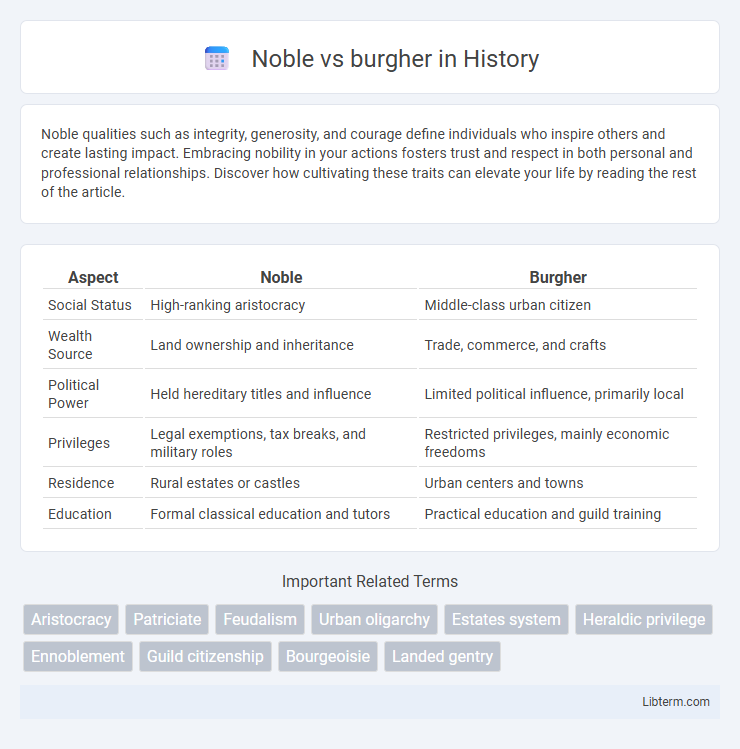Noble qualities such as integrity, generosity, and courage define individuals who inspire others and create lasting impact. Embracing nobility in your actions fosters trust and respect in both personal and professional relationships. Discover how cultivating these traits can elevate your life by reading the rest of the article.
Table of Comparison
| Aspect | Noble | Burgher |
|---|---|---|
| Social Status | High-ranking aristocracy | Middle-class urban citizen |
| Wealth Source | Land ownership and inheritance | Trade, commerce, and crafts |
| Political Power | Held hereditary titles and influence | Limited political influence, primarily local |
| Privileges | Legal exemptions, tax breaks, and military roles | Restricted privileges, mainly economic freedoms |
| Residence | Rural estates or castles | Urban centers and towns |
| Education | Formal classical education and tutors | Practical education and guild training |
Introduction: Defining Nobles and Burghers
Nobles were members of the aristocratic class, holding hereditary titles and extensive land ownership, often wielding political power and privileges in feudal societies. Burghers, in contrast, were urban middle-class citizens, typically merchants or skilled artisans, who gained economic influence through trade and industry in medieval and early modern towns. The distinction between nobles and burghers defined social hierarchy, economic roles, and political rights within historical European contexts.
Historical Origins of Nobility and Burghers
Nobility emerged in medieval Europe as a hereditary class granted land and privileges by monarchs in exchange for military service and loyalty, shaping feudal societies with distinct social hierarchies. Burghers originated in the growing urban centers during the Middle Ages, representing wealthy merchant and artisan classes who gained economic power through trade and crafts, often challenging noble dominance. This social dichotomy influenced political and economic structures, as nobles held traditional authority while burghers advanced economic development and urban governance.
Social Status and Class Distinctions
Nobles occupied the highest tier in medieval social hierarchy, holding hereditary titles, extensive land, and political power, symbolizing aristocratic privilege and dominance. Burghers, as members of the urban middle class, engaged in commerce, trade, and crafts, representing economic influence but limited political authority compared to nobility. The rigid class distinctions between noble landowners and burgher merchants underscored social stratification defined by birthright versus economic achievement.
Land Ownership and Economic Power
Nobles traditionally held vast estates granted by monarchs, establishing significant land ownership which ensured their dominant economic power in feudal society. Burghers, as urban middle-class merchants and craftsmen, controlled wealth through trade and commerce but typically lacked extensive land holdings. The economic influence of nobles derived from agrarian resources and labor, whereas burghers leveraged market networks and capital accumulation.
Political Influence and Governance Roles
Nobles held significant political influence through hereditary titles and land ownership, often occupying high-ranking government positions and advising monarchs directly. Burghers, typically wealthy merchants and city dwellers, gained political power mainly in urban centers via guilds and city councils, influencing local governance and economic policies. The divide between nobles and burghers shaped medieval and early modern power structures, with nobles dominating national politics while burghers controlled municipal administration.
Cultural Identity and Social Expectations
Nobles maintained cultural identity through hereditary privileges, elaborate rituals, and strict adherence to chivalric codes, reinforcing their elite social status and distinct lifestyle. Burghers, emerging from merchant and artisan classes, cultivated a cultural identity based on economic success, urban values, and practical education, reflecting their role in commerce and civic life. Social expectations for nobles emphasized honor, military service, and governance, while burghers were expected to contribute to economic growth, uphold bourgeois values, and engage in local self-administration.
Education and Access to Opportunities
Nobles historically received privileged education through private tutors and exclusive academies, granting them access to advanced knowledge and influential networks that secured leadership roles in government and military. Burghers, or middle-class city dwellers, typically attended local schools with more limited curricula focused on practical skills, which constrained their social mobility but enabled involvement in trade and crafts. The disparity in education quality and networking opportunities reinforced class divisions, with nobles maintaining dominance over political and economic power while burghers gradually expanded influence through commerce and urban growth.
Legal Privileges and Responsibilities
Nobles held exclusive legal privileges such as exemption from certain taxes, the right to be tried in special courts, and the authority to administer local justice, contrasting sharply with burghers who were subject to common laws and municipal regulations. Nobles had responsibilities tied to military service and governance, while burghers were primarily responsible for commercial duties, tax payments, and participation in guilds or town councils. The legal framework reinforced social hierarchies by granting nobles judicial autonomy and imposing stricter obligations on burghers within urban economic systems.
Conflicts and Cooperation Between Nobles and Burghers
Conflicts between nobles and burghers primarily stemmed from competing economic interests, with nobles seeking to maintain feudal privileges and burghers pushing for expanding trade rights and urban autonomy. Cooperation occurred when both classes aligned interests, such as in supporting monarchs who granted charters benefiting commerce while reinforcing noble authority. This dynamic interplay shaped medieval European social and political structures, influencing the evolution of towns and the decline of feudalism.
Lasting Impact on Modern Society
The distinction between nobles and burghers shaped modern societal structures by establishing early class-based governance and economic roles. Nobles influenced the development of centralized political power and legal systems, while burghers contributed to the rise of commerce, urbanization, and the middle class. This division laid the groundwork for contemporary social hierarchies and capitalist economies by promoting the balance between aristocratic authority and entrepreneurial innovation.
Noble Infographic

 libterm.com
libterm.com